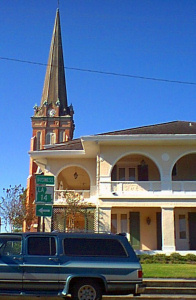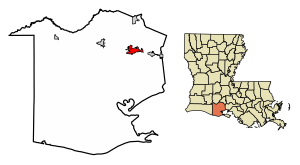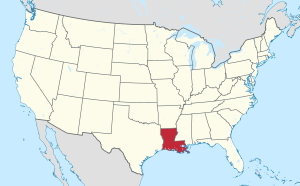Abbeville, Louisiana facts for kids
Quick facts for kids
Abbeville, Louisiana
|
|
|---|---|
 |
|

Location within Vermilion Parish and Louisiana
|
|

Location of Louisiana in the United States
|
|
| Country | United States |
| State | Louisiana |
| Parish | Vermilion |
| Incorporated | 1850 |
| Area | |
| • Total | 6.08 sq mi (15.74 km2) |
| • Land | 6.05 sq mi (15.66 km2) |
| • Water | 0.03 sq mi (0.08 km2) |
| Elevation | 16 ft (5 m) |
| Population
(2020)
|
|
| • Total | 11,186 |
| • Density | 1,849.84/sq mi (714.26/km2) |
| Time zone | UTC-6 (CST) |
| • Summer (DST) | UTC-5 (CDT) |
| ZIP code |
70510, 70511
|
| Area code(s) | 337 |
| FIPS code | 22-00100 |
Abbeville is a city in Louisiana, United States. It is the main city of Vermilion Parish. In 2020, about 11,186 people lived there. Abbeville is located about 21 miles (34 km) southwest of Lafayette.
Contents
History of Abbeville
Abbeville was once called La Chapelle. A Capuchin missionary, Father Antoine Désiré Mégret, bought the land on July 25, 1843, for $900.
How Abbeville Got Its Name
There are two ideas about how Abbeville got its name. The most accepted idea is that Father Mégret named the town after his hometown in France. Another idea is that the name combines "Abbé" (French for "Abbot" or "Father") and "ville" (French for "town"), meaning "Father's town."
However, in 1995, it was found that Antoine Jacques Désiré Mégret was born in Abbeville, France, in 1797. This supports the idea that he named the town after his birthplace.
Early Settlers and Development
Many of the first settlers were descendants of the Acadians. These people moved to the area from Nova Scotia between 1766 and 1775. Abbeville officially became a town in 1850.
When Father Mégret bought the land, Joseph LeBlanc and his wife Isabelle Broussard lived there. Father Mégret turned their home into a chapel. This chapel burned down in 1854. Later, in 1910, the St. Mary Magdalen Catholic Church was built. It is still there today.
Father Mégret planned the town like a French village. On a map from 1846, the town was about 38 to 40 acres (15 to 16 hectares) in size.
Magdalen Square
The center of downtown Abbeville is Magdalen Square. It has large oak trees, a fountain, and a gazebo. There is also a statue in the square to remember Father Mégret. In 1856, a big storm called the Last Island Hurricane destroyed every building in the town.
Geography and Climate
Abbeville is located at about 29°58′31.422″N 92°7′37.7652″W. It is about 16 feet (5 meters) above sea level. The city covers a total area of about 5.7 square miles (14.7 square kilometers). Most of this area is land, with a small amount of water.
Rivers and Transportation
The Vermilion River flows through downtown Abbeville. Several smaller canals and streams also run through the city. U.S. Highway 167 is a major road that goes through Abbeville. The Abbeville Chris Crusta Memorial Airport is in the eastern part of the city.
Climate in Abbeville
Abbeville has a humid subtropical climate. This means it has long, hot, and very humid summers. Winters are short, cool, and often windy. Spring and autumn have mild to warm temperatures.
It rains a lot in Abbeville throughout the year. The most rain falls between June and September. During these months, it rains twice as much as in winter. Even though it's hot, June to September are often cloudier. Clear and sunny skies are most common in the autumn.
| Climate data for Abbeville, Louisiana | |||||||||||||
|---|---|---|---|---|---|---|---|---|---|---|---|---|---|
| Month | Jan | Feb | Mar | Apr | May | Jun | Jul | Aug | Sep | Oct | Nov | Dec | Year |
| Mean daily maximum °F (°C) | 63.9 (17.7) |
65.7 (18.7) |
72.6 (22.6) |
78.7 (25.9) |
84.7 (29.3) |
89.9 (32.2) |
90.5 (32.5) |
91.2 (32.9) |
88.2 (31.2) |
81.7 (27.6) |
72.0 (22.2) |
64.5 (18.1) |
78.6 (25.9) |
| Mean daily minimum °F (°C) | 43.2 (6.2) |
45.0 (7.2) |
51.8 (11.0) |
58.0 (14.4) |
64.4 (18.0) |
70.8 (21.6) |
72.3 (22.4) |
72.6 (22.6) |
68.1 (20.1) |
57.8 (14.3) |
48.8 (9.3) |
43.8 (6.6) |
58.1 (14.5) |
| Average precipitation inches (mm) | 5.1 (130) |
4.1 (100) |
4.2 (110) |
4.1 (100) |
4.9 (120) |
6.4 (160) |
6.5 (170) |
6.0 (150) |
5.5 (140) |
4.3 (110) |
4.4 (110) |
5.0 (130) |
60.5 (1,540) |
| Source: Weatherbase | |||||||||||||
People of Abbeville
| Historical population | |||
|---|---|---|---|
| Census | Pop. | %± | |
| 1870 | 545 | — | |
| 1880 | 255 | −53.2% | |
| 1890 | 637 | 149.8% | |
| 1900 | 1,536 | 141.1% | |
| 1910 | 2,907 | 89.3% | |
| 1920 | 3,461 | 19.1% | |
| 1930 | 4,356 | 25.9% | |
| 1940 | 6,672 | 53.2% | |
| 1950 | 9,338 | 40.0% | |
| 1960 | 10,414 | 11.5% | |
| 1970 | 10,996 | 5.6% | |
| 1980 | 12,391 | 12.7% | |
| 1990 | 11,187 | −9.7% | |
| 2000 | 11,887 | 6.3% | |
| 2010 | 12,257 | 3.1% | |
| 2020 | 11,186 | −8.7% | |
| U.S. Decennial Census | |||
Abbeville is the main city in the Abbeville micropolitan area. This area includes all of Vermilion Parish. It is also part of the larger Lafayette metropolitan area.
Diversity in Abbeville
Here's a look at the different groups of people living in Abbeville as of 2020:
| Race | Num. | Perc. |
|---|---|---|
| White (non-Hispanic) | 4,970 | 44.43% |
| Black or African American (non-Hispanic) | 4,732 | 42.3% |
| Native American | 39 | 0.35% |
| Asian | 613 | 5.48% |
| Other/Mixed | 392 | 3.5% |
| Hispanic or Latino | 440 | 3.93% |
In 2000, most people (76.0%) over five years old spoke English at home. About 16.5% spoke French or Cajun, and 5.5% spoke Vietnamese.
In 2019, the average household income was $38,900. About 30.4% of the people lived at or below the poverty line.
Economy and Jobs
Abbeville is a center for farming and food processing. Important products include rice, sugarcane, dairy items, corn, cotton, and seafood. This seafood includes crawfish, alligator, and crab.
Companies in Abbeville also help support the oil and natural gas fields located off the coast in the Gulf of Mexico. The city also makes chemical products and goods for everyday use. A popular place to visit is a large mill that makes sugarcane syrup.
Education in Abbeville
The Vermilion Parish School District serves the city of Abbeville. Here are some of the schools:
Elementary Schools
- Eaton Park Elementary
- Herod Elementary
- Mount Carmel Elementary School (a private school, grades PK–8)
Middle Schools
- J.H. Williams Middle School
High Schools
- Abbeville High School
- Vermilion Catholic High School (a private school)
- Lighthouse Christian Prep. (a private school)
- James A. Herod High School and Elementary School (This school was started by Reverend James A. Herod to educate Black students in Vermilion Parish, from first to twelfth grade. He was also a teacher there.)
Fun Things to Do
Abbeville hosts several exciting festivals throughout the year:
- Daylily Festival and Garden Show
- Giant Omelette Celebration
- Les Lumieres du Village d'Abbeville
- Louisiana Cattle Festival
- Vermilion Carousel of Arts
The Abbey Players' Theater is a well-known local playhouse where you can watch shows. The Acadian Museum is just east of the city in Erath, Louisiana. About 15 miles (24 km) southeast of Abbeville is Avery Island. This island has a bird sanctuary, a salt dome, and the famous Tabasco factory.
Historic Buildings
Abbeville has many old buildings that are listed on the National Historic Register. This means they are important historical places.
In 1987, the Abbeville Commercial Historic District and the Abbeville Residential Historic District were added. The next year, the St. Mary Magdalen Church, Rectory, and the Cemetery were also added.
In the 1990s, several houses were added, including the Ovide Broussard House, Chauviere House, Gordy House, Lyons House, and the Caldwell House. The Downtown Abbeville Historic District was also added. Before the year 2000, the Richard Cattle Auction Barn and the St. Mary Congregational Church were added. North of Abbeville, A La Bonne Veillee was added in 1984.
National Guard
Abbeville is home to a part of the Louisiana Army National Guard. This is the HHC (headquarters company), 2nd Battalion, 156th Infantry (mech.). This battalion served with the 256th Infantry Brigade during Operation Iraqi Freedom in 2004–2005.
Transportation
The Louisiana & Delta Railroad has a train route through Abbeville. This helps move goods made in the area to markets.
The Freshwater Bayou Deepwater Channel connects Abbeville to the Gulf of Mexico. The Intracoastal Waterway also runs south of the city.
Abbeville in Movies and TV
Abbeville has been a filming location for several movies and TV shows:
- The 1988 remake of the movie The Blob was filmed in Abbeville.
- Part of Lucio Fulci's movie Door to Silence takes place in Abbeville.
- In 1948, filmmaker Robert J. Flaherty stayed in Abbeville for 15 months while filming Louisiana Story.
- Abbeville is one of the main places in the first season of the HBO TV series True Detective.
Famous People from Abbeville
Many notable people have connections to Abbeville:
- George A. Caldwell (1892–1966), a building contractor, was born in Abbeville.
- Bobby Duhon (born 1946), a professional American football player.
- Bobby Charles Guidry (1938–2010), a songwriter and musician who wrote "See You Later Alligator," was born in Abbeville.
- Sammy Kershaw (born 1958), a country music artist, lives in Abbeville.
- Dudley J. LeBlanc (1894–1971), a businessman and politician, lived most of his life and died in Abbeville.
- Koryn Hawthorne (born 1997), a finalist on season 8 of The Voice.
- Anthony Levine (born 1987), a professional American football player, was born in Abbeville.
- Gerald Long (born 1944), a state senator, used to live in Abbeville.
- Brandon Mitchell (born 1975), a former professional American football player, was born in Abbeville.
- Deb Richard (born 1963), a golfer who won five LPGA Tour tournaments.
- Sam H. Theriot (born 1954), a former member of the Louisiana House of Representatives and educator, is from Abbeville.
- Golden J. Zenon Jr. (1929–2006), an architect, was born in Abbeville.
See also
 In Spanish: Abbeville (Luisiana) para niños
In Spanish: Abbeville (Luisiana) para niños

